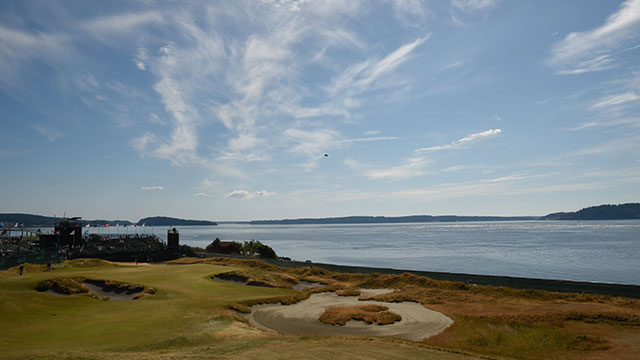NEWS
It's showtime for Chambers Bay

UNIVERSITY PLACE, Wash. -- Ready or not, the show begins.
Over several years, hundreds of people have spent thousands of hours getting ready for this, the first U.S. Open held in the Northwest. The payoff for that work begins at 7 a.m. Thursday, with the first tee shots of the event, by two local players, no less: Michael Putnam, who lives about a 25-minute walk from the course, and Troy Kelly, who can see the course from his Steilacoom home.
A strong case can be made that this is the biggest sporting event ever held in the Northwest. When the USGA put out the call for 5,200 volunteers, the spots were filled in record time: 36 hours. It usually takes a couple of months. Tickets to the championship rounds have been sold out for months. The $125 single-day tickets are going for substantially more on the secondary market.
This excitement is what John Ladenburg, the former Pierce County executive, dreamed of when he came up with the idea to turn what was a gravel and sand mine into a golf course and public-use area. But not just any course: a county-owned course that could host a U.S. Open.
Of the 250,000 people expected this week at Chambers Bay, you will be hard-pressed to find one more excited or proud. Just look for the guy with the biggest smile.
"We wanted to do something on a scale that hadn't been done here before," Ladenburg said. "We wanted to build a world-class golf course that would be a tourist attraction, and we wanted to have a major tournament, and particularly the U.S. Open."
SCORES: U.S. Open Round 1 | PHOTOS: Thursday's best images
Pat McCarthy, who succeeded Ladenburg as Pierce County executive, does not play golf but is a frequent walker of the public trails that run through the course.
She jokes that proponents of the course must have been worried when she was elected, but she has never wavered in her support, believing that hosting a U.S. Open would be a boon not only for Chambers Bay, but the entire region.
We wanted to do something on a scale that hadn't been done here before" -- John Ladenburg, former Pierce County executive
For years, McCarthy and key members of Pierce County and other local governments have been attending U.S. Opens, gleaning anything that might help them. Finally, their turn has arrived.
"It's kind of mind-blowing," McCarthy said. "It's really special, and it's hard to even put into words because we've put in so much work and we want it to continue to be successful every day -- for the fans, for the community, for the players, for all of our partners. We're holding our breath to make sure it all works well."
While all this is new to the Northwest, this is also uncharted territory for the USGA. The organization has previously had a reputation of being a bit staid and set in its ways, but it went outside the box when it selected Chambers Bay in 2008 -- about eight months after the course had opened -- to host this U.S. Open. It went way, way outside the box.
The decision to bring the U.S. Open to University Place shocked the golfing world. Until then, only the most prestigious and hallowed courses had been picked to host the national championship, and no course built in the previous 45 years had hosted an Open.
But the decision went beyond that.
It's also the first time the tournament has been held on a links-style course: a virtually treeless landscape on a windswept, seaside site where there will be more than one good way for a player to get the ball from the tee to the hole. Also new is the fine fescue grass, which is common at courses in Great Britain but rare stateside.
The newness of it all seems to have amped up the excitement at the USGA. It's palpable when listening to USGA President Tom O'Toole.
"I think there's extra excitement for a variety of reasons," he said. "This is the first time we've come to the Pacific Northwest, and as I keep saying, we've had 114 of these championships and never came here.
CHAMBERS BAY: It takes an army
"So that's story No. 1: bringing the national championship to this region, which obviously is a wonderful, golf-supporting region. And then the difference and uniqueness of the course is the other thing that I think has got us excited.
"We want to be relevant to golfers. We're having a national championship at a golf course that's public and in a region we've never been to. And that, I think, is making us more relevant."
For championship coordinator Danny Sink, who oversaw all logistics outside the ropes, including transportation, coming to a new site brought unforeseen challenges. It didn't always go as planned. He had envisioned a train stop near the course entrance, for example, and that did not materialize. But overall, he was quite happy and said the project invigorated him.
"When you go to an event year after year, we know what's worked before," he often said.
"The great thing here is we have a blank slate, and no options are off the table. We had the opportunity to do something special inside and outside the ropes."
Ah, the inside-the-ropes part. For all the years of preparation, that is what it's all about. Four days of golf to determine a national champion (five days if there is a tie after Sunday). How hard will the course play? What will the players think? No one knows for sure, but it's time to find out.
The world is ready to watch.
This article was written by Scott Hanson from Seattle Times and was legally licensed through the NewsCred publisher network.
